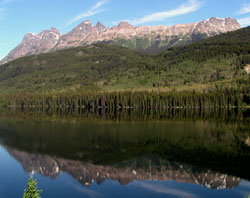
Photo: Leather Peak (left) and Lucerne Peak from the east on the Yellowhead Highway
Leather Peak
- 2457 m (8,061ft)
- Naming History
Located on the continental divide in the Fraser River Valley; a peak of Yellowhead Mountain
Province: Alberta/BC
Park: Jasper/Mount Robson
Headwater: Athabasca/Fraser
Visible from Highway: 16
Named by: Arthur Wheeler
Named for: The name of this mountain commemorates "Leather Pass," a name used for Yellowhead Pass during the 1860's, 1870's, and 1880's. It refers to the moose and caribou skins carried through the pass by fur traders.
Yellowhead Mountain lies to the west of Yellowhead Pass and northwest of Yellowhead Lake. It is not certain who the pass, and subsequently the mountain, was named after but the most likely candidate is Pierre Bostonais, a blonde Iroquois trapper who was nicknamed "Yellow-head". In 1820, he guided one of the first Hudson Bay Company parties through the pass. FOUR HIGH POINTS There are four named high points on Yellowhead Mountain. From east to west they are Tete Roche, Lucerne Peak, Leather Peak, and Bingley Peak. The first three are on the Continental Divide but Bingley Peak lies entirely in British Columbia. Tete Roche (2418 m - 7,933 ft) is the peak at the northeastern end of Yellowhead Mountain. It is named for the trapper who used to store his furs near Tete Jaune Cache. Lucerne Peak (2412 m - 7,913 ft) lies to the southwest of Tete Roche and east of Leather Peak. The Canadian Northern Pacific Railway reached Yellowhead Lake in 1913 and named their station there after Lucerne, Switzerland which is also situated on a lake. This provided the nucleus of a town which, for a time, had a population approaching three hundred and rivalled Jasper. However, in 1924 the "railway divisional point" moved from Lucerne to Jasper and many of the residents relocated to Jasper. (Lucerne's railway station was the size of Jasper's and was not demolished until after the Second World War.) Located between Bingley Peak and Lucerne Peak, Leather Peak is the highest point on Yellowhead Mountain. It was named by Arthur Wheeler in 1918. The name of this mountain commemorates "Leather Pass," a name used for Yellowhead Pass during the 1860's, and 1880's. It refers to the moose and caribou skins carried through the pass by fur traders. Bingley Peak (2438 m - 7,998 ft) forms the western end of Yellowhead Mountain. In their book, "The North-West Passage by Land" that describes their trip through the Rockies in 1863, Milton and Cheadle describe the view of the mountains from "Buffalo Dung Lake" (now known as Yellowhead Lake) and go on to write, "Two of these on opposite sides of the lake were particularly fine, one to the north-west, the other to the south-west; and the Iroquois assured us that they should be known from that time forth as "Le Montagne de Milord" and "Montague de Docteur". We, however, took the liberty of naming them Mount Fitzwilliam and Mount Bingley." William Fitzwilliam (Viscount Milton) and Dr. Walter Butler Cheadle travelled up the Athabasca River and in 1863 they became the first "tourists" to travel through the Yellowhead Pass. Arriving in Quebec City in July of 1862, they travelled across the continent, wintering near Fort Carlton. After a challenging and at times humorous summer they reached Victoria, BC.
